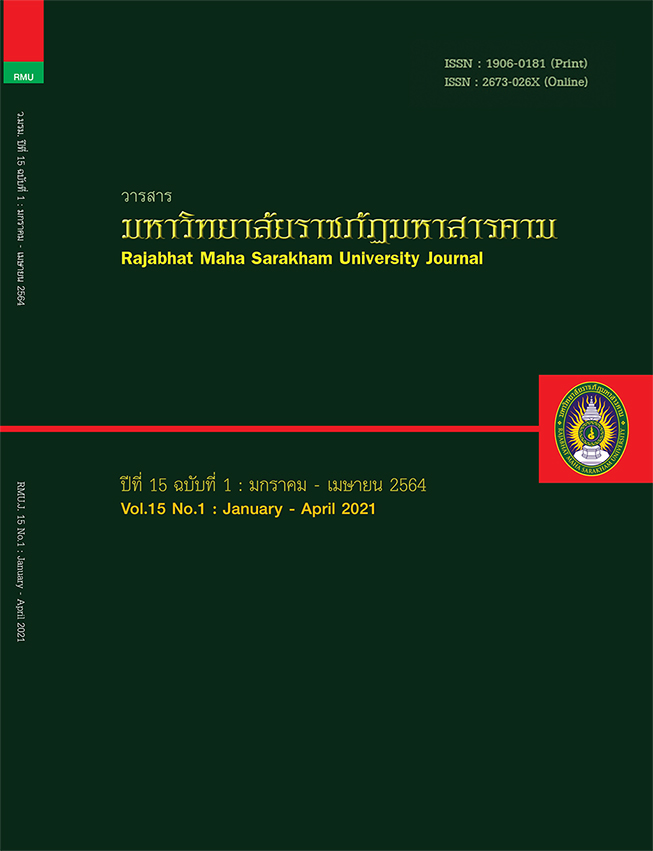การใช้วงจรวรรณกรรมเพื่อพัฒนาความสามารถด้านพหุวัฒนธรรมของนักศึกษาระดับปริญญาบัณฑิต
Main Article Content
บทคัดย่อ
การวิจัยครั้งนี้มีวัตถุประสงค์เพื่อศึกษาความสามารถทางด้านพหุวัฒนธรรมของนักศึกษาระดับปริญญาบัณฑิต โดยใช้กิจกรรมวงจรวรรณกรรม กลุ่มตัวอย่างคือ นักศึกษาวิชาเอกภาษาอังกฤษชั้นปีที่ 2 คณะครุศาสตร์ มหาวิทยาลัยราชภัฏอุตรดิตถ์ จำนวน 24 คน โดยการเลือกแบบเจาะจง (Purposive Sampling) ซึ่งกลุ่มตัวอย่างเหล่านี้คือ ผู้ที่ลงทะเบียนในรายวิชานิทานและวรรณกรรมสำหรับเด็กในภาคเรียนที่ 2 ปีการศึกษา 2561 เครื่องมือที่ใช้ในการศึกษาคือ 1) แผนการสอนที่ใช้กิจกรรมวงจรวรรณกรรม 5 บท 2) แบบทดสอบความสามารถทางด้านพหุวัฒนธรรม และ 3) การเขียนโต้ตอบวรรณกรรม สถิติที่ใช้คือ t-test ซึ่งนำมาใช้เพื่อเปรียบเทียบความสามารถทางด้านพหุวัฒนธรรมของนักศึกษาก่อนและหลังการใช้วงจร วรรณกรรมในห้องเรียนวิชานิทานและวรรณกรรมสำหรับเด็ก ค่าเฉลี่ย และส่วนเบี่ยงเบนมาตรฐานของคะแนนความสามารถทางด้านพหุวัฒนธรรม อีกทั้งการวิเคราะห์เนื้อหาได้ถูกนำมาใช้ในการวิเคราะห์ความสามารถทางพหุวัฒนธรรมของนักศึกษาหลังจากการใช้กิจกรรมวงจรวรรณกรรม การศึกษานี้พบว่าความสามารถทางพหุวัฒนธรรมของนักศึกษาดีขึ้นหลังจากการใช้วงจรวรรณกรรม ผลการทดสอบก่อนเรียนและคะแนนหลังเรียนของนักเรียนที่ได้รับกิจกรรมวงจรวรรณกรรมแตกต่างกันอย่างมีนัยสำคัญทางสถิติที่ระดับ .05 แสดงว่าการใช้กิจกรรมวงจรวรรณกรรมส่งเสริมการพัฒนาความสามารถหลากหลายทางวัฒนธรรมของนักศึกษา และนอกจากนั้น นักศึกษายังได้พัฒนาความสามารถทางพหุวัฒนธรรมที่พวกเขาได้รับเมื่อกิจกรรมวงจรวรรณกรรมถูกนำไปใช้กับห้องเรียนวิชานิทานและวรรณกรรมสำหรับเด็ก นักศึกษาส่วนใหญ่พัฒนาขึ้นในด้านความรู้เกี่ยวกับวัฒนธรรม ส่วนประกอบและวัตถุประสงค์ของวัฒนธรรม บรรทัดฐาน ขนบธรรมเนียม ประเพณีและค่านิยมอีกด้วย
Article Details

อนุญาตภายใต้เงื่อนไข Creative Commons Attribution-NonCommercial-NoDerivatives 4.0 International License.
1. บทความที่ลงตีพิมพ์ทุกเรื่องได้รับการตรวจทางวิชาการโดยผู้ประเมินอิสระ ผู้ทรงคุณวุฒิ (Peer Review) สาขาที่เกี่ยวข้อง อย่างน้อย 3 ท่าน ในรูปแบบ Double blind review
2. ข้อคิดเห็นใด ๆ ของบทความที่ลงตีพิมพ์ในวารสารมหาวิทยาลัยราชภัฏมหาสารคาม นี้เป็นของผู้เขียน คณะผู้จัดทำวารสารไม่จำเป็นต้องเห็นด้วย
3. กองบรรณาธิการวารสารมหาวิทยาลัยราชภัฏมหาสารคาม ไม่สงวนสิทธิ์การคัดลอกแต่ให้อ้างอิงแสดงที่มา
เอกสารอ้างอิง
Balone, E. (2015). Effects of the literature circle strategy on participation of English language learners [Unpublished master thesis]. University of New York.
Barrette, C. & Paesani, K. & Vinall, K. (2010). Toward an Integrated Curriculum: Maximizing the Use of Target Language Literature. Foreign Language Annals. 43. 216-230. 10.1111/j.1944-9720.2010.01075.x.
Bedel, O. (2016). Collaborative learning through literature circles in EFL. European Journal of Language and Literature Studies, 6(1), 96-99.
Brabham, E.G., & Villaume, S.K. (2000). Questions and answers: Continuing conversations about literature circles. The Reading Teacher, 54(3), 278-280.
Briggs, S.R. (2010). Using literature circles to increase reading comprehension in third grade elementary students. San Rafael, CA.
Calvillo, E., Clark, L., Ballantyne, J. E., Pacquiao, D., Purnell, L. D., & Villarruel, A. M. (2009). Cultural competency in baccalaureate nursing education. Journal of Transcultural Nursing, 20, 137-145.
Carrison, C. & Ernst-Slavit, G. (2005). From silence to a whisper to active participation: Using literature circles with ELL students. Reading Horizon, 46(2), 93-113.
Civelekoglu, N. & Saka, F. O. (2017). The Use of Poetry to Raise Intercultural Awareness of EFL Students. The Journal of Language Teaching and Learning, 8(1), 39-52.
Cheng, K. (2008). Issues in the Teaching and Learning of Children’s Literature in Malaysia. 112-125. Retrieved from http://puslit2.petra.ac.id/ejournal/index.php/ing/article/viewArticle/ 16693.
Daniels, H. (2002). Literature circles: Voice and choice in book clubs and reading groups. (2nd ed.). Maine: Stenhouse Publishers.
Graham-Marr, A. (2015). Elevating the development of listening skills to foster SLA in an Asian context. Journal of Foreign Language Teaching and Applied Linguistics, 2(2), 1-6.
Irawati, D. (2016). Effectiveness of Literature Circles on Students’ Reading Comprehension. IJOLTL. 1(3), 179-192.
Jacobs, M. (2015). Using literature circles to increase reading comprehension and student motivation. Theses and Dissertations. 568. Retrieve from https://rdw.rowan.edu/etd/568
Khatib M. (2011). Literature in EFL/ESL Classroom. English Language Teaching. Canadian Center of Science and Education 2011. 4(1). 1-8. Retrieved From https://files.eric.ed.gov/fulltext/EJ1080411.pdf
Martin, M., Vaughn, B.E., (2007). Cultural competence: The nuts and bolts of diversity and inclusion. In Strategic Diversity & Inclusion Management Magazine, 1(1).
McElvain, C. (2010). Transactional literature circles and the reading comprehension of English learners in the mainstream classroom. Journal of Research in Reading, 33(2), 178-205. Retrieve March 15, 2020, from https://doi.org/10.1111/j.1467-9817.2009.01403.
Reisinger, Y. (2009). International Tourism: Cultures and Behavior. (1st ed.). USA. Elsevier.
Tashakkori, A., & Teddlie, C. (Eds.). (2003). Handbook of mixed methods in social & behavioral research. Thousand Oaks, CA: Sage.
Tracey, D. & Morrow, L. M. (2006). Lenses on reading: An introduction to theories and models. New York, NY: Guilford Press.
Van, T. T. M. (2009). The relevance of literary analysis to teaching literature in the EFL classroom. English Teaching Forum, 47(3), 2-9. Retrieved from http://eric.ed.gov/?id=EJ923454.
Vernooy, J. and Harris, C. (2010). Multicultural Competence in the WSU Curriculum: A Proposal. Retrieved from http://www.wright.edu/academicaffairs/policies/.
MulticulturalCompetence.pdf Wilfong, L. G. (2009). Textmasters: bringing literature circles to textbook reading across the curriculum. Journal of Adolescent & Adult Literacy, 53(2), 164-171. Retrieve from https://doi.org/10.1598/JAAL.53.2.7


